Bael fruit, Bengal quince
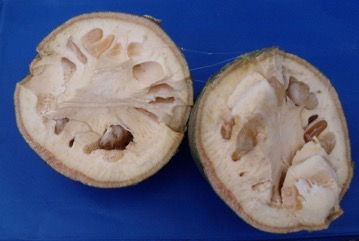
A tropical plant. It prefers rich well drained soils in an open sunny position. It suits tropical or warm places. It appears to do best where there is a distinct dry season. It is drought and frost tender. It grows in Nepal to about 1100 m altitude. A hot dry summer is best. It can tolerate some alkalinity and saline soils. It can tolerate alkalinity. It can grow in arid places. In Yunnan.
Also known as:
Aluvigam, Arbol de bael, Bak tuum, Beel, Bel, bela, Belang, Beli, Bella, Belo, Belpatri, Belthei, Belu, Bil, Bila, Bilak, Bili, Bilpatre, Bilva, Bnau, Chilongpak chi, Golden apple, Hpun ja, Indian bael, Indian quince, Iyalbudi, Kawista, Kia-bok, Koovalam, Ma pin, Maak tum, Mahafal, Mak-phyn, Maja batu, Maja ingus, Maja, Mak tum, Maredoo, Maredu, Marmelo, Matoon, Matoom, Matum, Muredu, Okshit, Opesheet, Phnao, Phneu, Pnoeu, Pohon maja manis, Sinje dari, Sirphal, Soh-bel, Srifal, Thepli, Toum, Tum, Vilva marum, Vilvam, Vilvan, Yod maak tuum
Synonyms
- Aegle marmelos var. mahurensis Zate
- Belou marmelos (L.) A. Lyons
- Bilacus marmelos (L.) Kuntze
- Crateva marmelos L.
- Feronia pellucida Roth.
Edible Portion
- Fruit, Leaves condiment, Spice, Vegetable
Where does Bael fruit grow?
Found in: Africa, Andamans, Asia, Australia, Bangladesh, Bhutan, Brazil, Cambodia, China, Cuba, East Africa, East Timor, Fiji, Guianas, Hawaii, Himalayas, India, Indochina, Indonesia, Laos, Malaysia, Mexico, Myanmar, Nepal, Nigeria, North America, Northeastern India, NW India, Pacific, Pakistan, Papua New Guinea, PNG, Philippines, Pohnpei, SE Asia, Singapore, South America, Sri Lanka, Suriname, Taiwan, Tanzania, Thailand, Timor-Leste, Uganda, United States, Vietnam, West Africa
Notes: There are 3 Aegle species. In some places the fruit is used as treatment for diarrhoea. The tree is common in temple gardens in India. It has anticancer properties.
Status: Fruit are sold in markets. It is commonly cultivated.
Growing Bael fruit, Bengal quince
Cultivation: It is grown from seed. Seed are taken from freshly picked ripe fruit. Seedlings are planted out after one year. It can be grown from root offshoots. They are best grown using patch budding. Trees are spaced 6-9 m apart. Trees can be pruned to have 4-6 strong branches. Suckers should be removed. It can also be grown from root suckers or air layering.
Edible Uses: The ripe fruit are eaten raw. They are also used to make drinks. The fruit are often sliced and dried. Marmalade can be made from ripe pulp. They can also be pickled or used in jams and jellies. The young shoots and leaves can be eaten raw in salad. They are also used in chutneys. The flowers are used to make a drink. CAUTION: There are reports that leaves make women sterile or cause abortions.
Production: It is slow growing. Trees produce in 3-4 years. Full production is gained after 15 years. Fruit are produced throughout the year. Fruit should be picked and not allowed to drop. There can be 200-400 fruit per tree. A fruit can weigh 1 kg. Fruit ripen in the dry season. Fruit can be ripened off the tree. Trees can continue bearing for 50 years. The fruit can be stored for 2 weeks at 30°C and for 4 months at 10°C.
Nutrition Info
per 100g edible portion| Edible Part | Energy (kcal) | Protein (g) | Iron (mg) | Vitamin A (ug) | Vitamin c (mg) | Zinc (mg) | % Water |
|---|---|---|---|---|---|---|---|
| Fruit | 138 | 2.3 | 0.55 | 0.13 | 219 | - | 58 |
| Leaves | - | - | - | - | - | - | |
| Flowers | - | - | - | - | - | - |
Bael fruit, Bengal quince Photos

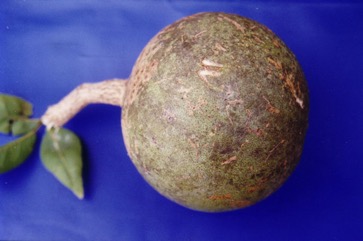
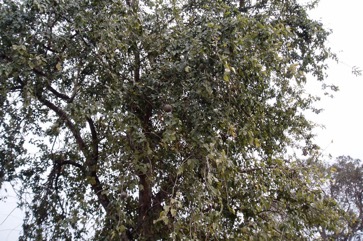
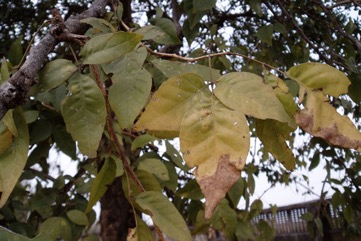
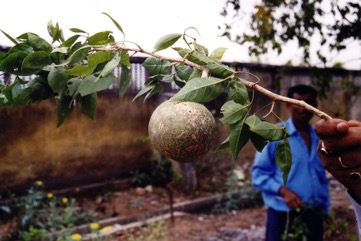
References
Acharya K. P. and Acharya, R., 2010, Eating from the Wild: Indigenous knowledge on wild edible plants in Parroha VDC of Rupandehi District, Central Nepal. International Journal of Social Forestry. 3(1):28-48
Ambasta S.P. (Ed.), 2000, The Useful Plants of India. CSIR India. p 16
Arinathan, V., et al, 2007, Wild edibles used by Palliyars of the western Ghats, Tamil Nadu. Indian Journal of Traditional Knowledge. 6(1) pp 163-168
Arora, R. K., 2014, Diversity in Underutilized Plant Species - An Asia-Pacific Perspective. Bioversity International. p 56
Aryal, K. P. et al, 2009, Uncultivated Plants and Livehood Support - A case study from the Chepang people of Nepal. Ethnobotany Research and Applications. 7:409-422
Aryal, K. P., et al, 2018, Diversity and use of wild and non-cultivated edible plants in the Western Himalaya. Journal of Ethnobiology and Ethnomedicine (2018) 14:10
Ashton, M. S., et al 1997, A Field Guide to the Common Trees and Shrubs of Sri Lanka. WHT Publications Ltd. pdf p 343
Bajpai, O., et al, 2015, Tree species of the Himalayan Terai region of Uttar Pradesh, India: a checklist. Check List 11(4): 1718
Bandyopadhyay, S., et al, 2012, A Census of Wild Edible Plants from Howrah District, West Bengal, India. Proceedings of UGC sponsored National Seminar 2012
Barwick, M., 2004, Tropical and Subtropical Trees. A Worldwide Encyclopedic Guide. Thames and Hudson p 12
Basha, S. K. M., Ethnobotanical Trees of Sri Lanka Malleswara Wildlife Sanctuary; Eastern Ghats, Andhra Pradesh.
Behera, K. K. et al, 2008, Wild Edible Plants of Mayurbhanj District, Orissa, India. J. Econ. Taxon. Bot. Vol. 32 (Suppl,) pp 305-314
Bhardwaj, J. & Seth, M. K., 2017, Edible wild plant resources of Bilaspur, Hamirpur and Una districts of Himachal Pradesh, India. International Journal of Botany Studies. Volume 2; Issue 6; p 09-17
Bircher, A. G. & Bircher, W. H., 2000, Encyclopedia of Fruit Trees and Edible Flowering Plants in Egypt and the Subtropics. AUC Press. p 10
Bodkin, F., 1991, Encyclopedia Botanica. Cornstalk publishing, p 51
Bohra, N., et al, 2017, Ethnobotany of wild edible plants traditionally used by the local people in the Ramnagar regions from Nainital District, Uttarakhand, India. Biolife 5(1): 12-19
Bole, P.V., & Yaghani, Y., 1985, Field Guide to the Common Trees of India. OUP p 9
Brahma, S., et al, 2013, Wild edible fruits of Kokrajhar district of Assam, North-East India, Asian Journal of Plant Science and Research 3(6):95-100
Brouk, B., 1975, Plants Consumed by Man. Academic Press, London. p 156
Burkill, H. M., 1985, The useful plants of west tropical Africa, Vol. 4. Kew.
Burkill, I.H., 1966, A Dictionary of the Economic Products of the Malay Peninsula. Ministry of Agriculture and Cooperatives, Kuala Lumpur, Malaysia. Vol 1 (A-H) p 56
Chandrakumar, P., et al, 2015, Ethnobotanical studies of wild edible plants of Gond, Halba and Kawar tribes of Salekasa Taluka, Gondia District, Maharashtra State, India. International Research Journal of Pharmacy 6(8)
Chandrashekara, U. M., 2009, Tree species yielding edible fruit in the coffee-based homegardens of Kerala, India: their diversity, uses and management. Food Sec. 1:361-370
Chowdery, T., et al, 2014, Wild edible plants of Uttar Dinajpur District, West Bengal. Life Science Leaflets. 47:pp 20-36 http://lifesciencesleaflets.ning.com
Chowdhury, M. & Mukherjee, R., 2012, Wild Edible Plants Consumed by Local Communities of Maldah of West Bengal, India. Indian J.Sci.Res.3(2) : 163-170
Coronel, R.E., 1982, Fruit Collections in the Philippines. IBPGR Newsletter p 6
Cowie, I, 2006, A Survey of Flora and vegetation of the proposed Jaco-Tutuala-Lore National Park. Timor-Lests (East Timor) www.territorystories.nt/gov.au p 52
Cruz-Garcia, G. S., & Price, L. L., 2011, Ethnobotanical investigation of 'wild' food plants used by rice farmers in Kalasin, Northeast Thailand. Journal of Ethnobiology and Ethnomedicine 7:33
Darley, J.J., 1993, Know and Enjoy Tropical Fruit. P & S Publishers. p 118
Das, S. and De, B., 2013, Evaluation of Angiotension I-Converting Enzyme (ACE) inhibitory potential of some underutilized indigenous fruits of West Bengal using an in vitro model. Fruits, Vol. 68:499-506
Das, T. & Das, A. K., 2005, Inventorying plant biodiversity in homegardens: A case study in Barak Valley, Assam, North East India. CURRENT SCIENCE, VOL. 89, NO. 1, 10 JULY 2005
Datar, M. N. & Upadhye, A. S., 2016, Forest foods of northern region of Western Ghats. MACS - Agharkar Research Institute, Pune. Pp 1-160. ISBN: 978-93-85735-10-3 p 15
Dobriyal, M. J. R. & Dobriyal, R., 2014, Non Wood Forest Produce an Option for Ethnic Food and Nutritional Security in India. Int. J. of Usuf. Mngt. 15(1):17-37
Dyani, S.K., & Sharma, R.V., 1987, Exploration of Socio-economic plant resources of Vyasi Valley in Tehri Garwhal. J. Econ. Tax. Bot. Vol. 9 No. 2 pp 299-310
Ethnobotany of Karbis. Chapter 4 in p 103
Facciola, S., 1998, Cornucopia 2: a Source Book of Edible Plants. Kampong Publications, p 213
Flora of Pakistan. www.eFloras.org
Food Composition Tables for use in East Asia FAO http://www.fao.org/infoods/directory No. 822
GAMMIE,
Gardner, S., et al, 2000, A Field Guide to Forest Trees of Northern Thailand, Kobfai Publishing Project. p 102
Gouldstone, S., 1983, Growing your own Food-bearing Plants in Australia. Macmillan p 77
GUPTA,
Hazarika, T. K., et al, 2012, Studies on wild fruits of Mizoram, India used as ethno-medicines. Genetic Resources and Crop Evolution. Published on line 03 February, 2012
Hearne, D.A., & Rance, S.J., 1975, Trees for Darwin and Northern Australia. AGPS, Canberra p 15
Hedrick, U.P., 1919, (Ed.), Sturtevant's edible plants of the world. p 27
http://palaeoworks.anu.edu.au/Nuno_PhD/04.pdf re Timor
Jacquat, C., 1990, Plants from the Markets of Thailand. D.K. Book House p 72
Jadhav, R., et al, 2015, Forest Foods of Northern Western Ghats: Mode of Consumption, Nutrition and Availability. Asian Agri-History Vol. 19, No. 4: 293-317
Japanese International Research Centre for Agricultural Science www.jircas.affrc.go.jp/project/value_addition/Vegetables
Jeeva, S., 2009,Horticultural potential of wild edible fruits used by the Khasi tribes of Meghalaya. Journal or Horticulture and Forestry Vol. 1(9) pp. 182-192
Jindal, M., et al, 2013, Synthesis, physico-chemical and biomedical applications of sulfated Aegle marmelos gum: Green chemistry approach. Arabian Journal of Chemistry.
John, L., & Stevenson, V., 1979, The Complete Book of Fruit. Angus & Robertson p 76
Kahlon, L. K. & Singh, R., 2019, Traditional knowledge & Dynamics of edible plants of primitive tribal group ‘Paudi Bhuyan’ with changing demography migration patterns in Northern Odisha. Indian Journal of Traditional Knowledge Vol 18(1), pp 7-15
Khan, D. & Shaukat, S.S., 2006, The Fruits of Pakistan: Diversity, Distribution, Trends of Production and Use. Int. J. Biol. Biotech., 3(3):463-499
Khan, M. & Hussain, S., 2014, Diversity of wild edible plants and flowering phenology of district Poonch (J & K) in the northwest Himalaya. Indian Journal of Sci, Res. 9(1): 032-038
Khanal, R., et al, 2014, Documenting abundance and use of underutilized plant species in the mid hill region of Nepal. ECOPRINT 21: 63-71, 2014
Khumgratok, S., Edible Plants in Cultural Forests of Northeastern Thailand. Mahasarakham University Thailand.
Kintzios, S. E., 2006, Terrestrial Plant-Derived Anticancer Agents and Plant Species Used in Anticancer research Critical Reviews in Plant Sciences. 25: pp 79-113
Kiple, K.F. & Ornelas, K.C., (eds), 2000, The Cambridge World History of Food. CUP p 1725
Krishen P., 2006, Trees of Delhi, A Field Guide. DK Books. p 198
Lorenzi, H., Bacher, L., Lacerda, M. & Sartori, S., 2006, Brazilian Fruits & Cultivated Exotics. Sao Paulo, Instituto Plantarum de Estuados da Flora Ltda. p 525
Luczaj, L., et al, 2021, Wild food plants and fungi sold in the markets of Luang Prabang, Lao PDR. Journal of Ethnobiology and Ethnomedicine (2021) 17:6
Lyle, S., 2006, Discovering fruit and nuts. Land Links. p 52
Macmillan, H.F. (Revised Barlow, H.S., et al) 1991, Tropical Planting and Gardening. Sixth edition. Malayan Nature Society. Kuala Lumpur. p 290
Manandhar, N.P., 2002, Plants and People of Nepal. Timber Press. Portland, Oregon. p 74
Martin, F.W. & Ruberte, R.M., 1979, Edible Leaves of the Tropics. Antillian College Press, Mayaguez, Puerto Rico. p 98, 217
Martin, F. W., et al, 1987, Perennial Edible Fruits of the Tropics. USDA Handbook 642 p 64
Medhi, P. & Borthakur, S. K., 2012, Phytoresources from North Cachur Hills of Assam -3: Edible plants sold at Hflong market. Indian Journal of Natural Products and Resources. 3(1) pp 84-109
Miguel, E., et al, 1989, A checklist of the cultivated plants of Cuba. Kulturpflanze 37. 1989, 211-357
Milow, P., et al, 2014, Malaysian Species of Plants with Edible Fruits or Seeds and Their Valuation. International Journal of Fruit Science, 14:1-27, 2014
Morton, J. F., 1987, Fruits of Warm Climates. Wipf & Stock Publishers p 187
Murtem, G. & Chaudhrey, P., 2016, An ethnobotanical note on wild edible plants of Upper Eastern Himalaya, India. Brazilian Journal of Biological Sciences, 2016, v. 3, no. 5, p. 63-81.
Pandy, R. K. & Saini, S. K., 2007, Edible plants of tropical forests among tribal communities of Madhya Pradesh. Indian Journal of Traditional Knowledge. 6(1), pp 185-190
Pandey, K. C. & Pande, N., 2016, Ethnobotanical Documentation of Wild Edible Plants used by Gujjar Community of Tarai West Forest Division Ramnagar, Nainital, India, Current World Environment. Vol. 11(3), 808-818
Patel, K. P., Sahu, J., Sahu, L., Prajapati, N. K. and Dubey, B. K., 2012, Aegle marmelos:A Review on its Medicinal Properties, Int. J. Pharm. Phytopharmacol. Res., 1(5): pp. 332-338.
Patiri, B. & Borah, A., 2007, Wild Edible Plants of Assam. Geethaki Publishers. p 21
Paul, A., 2013, Minor and uncultivated fruits of Eastern India, 2nd International Symposium on Minor Fruits and Medicinal Plants
Phon, P., 2000, Plants used in Cambodia. © Pauline Dy Phon, Phnom Penh, Cambodia.
Prachi, K., et al, 2012, Underutilized wild fruits of North Maharashtra. Journal of Research in Plant Sciences. (2012) 1:071-076
PROSEA (Plant Resources of South East Asia) handbook, Volume 2, 1991, Edible fruits and nut. p 59
PROSEA handbook Volume 13 Spices. p 273
Purseglove, J.W., 1968, Tropical Crops Dicotyledons, Longmans. p 493
Rajapaksha, U., 1998, Traditional Food Plants in Sri Lanka. HARTI, Sri Lanka. p 418
Rajendra, K.C., 2014. Prominent Non-Wood Forest Products of Te- rai and Siwalik Regions in Nepal. Food and Agriculture Organization, Kathmandu, Nepal. p 49
Rao, M. L. S., et al, 2014, Indigenous Plant Foods which are commonly consumed by the tribal communities in Dumbriguda Area of Visakhapatnam District, Andhra Pradesh, India. Biolife. Vol 2, Issue 3
Rashid, H. E., 1977, Geography of Bangladesh. Westview. p 348
Reddy, B. M., 2012, Wild edible plants of Chandrapur district, Maharashtra, India. Indian Journal of Natural Products and Resources. 3(1) pp 110-117
Reddy, K. N., et al, 2006, Traditional knowledge on wild food plants in Andhra Pradesh. Indian Journal of Traditional Knowledge 6(1) pp 223-229
Royal Botanic Gardens, Kew (1999). Survey of Economic Plants for Arid and Semi-Arid Lands (SEPASAL) database. Published on the Internet; http://www.rbgkew.org.uk/ceb/sepasal/internet [Accessed 10th June 2011]
Sahni, K.C., 2000, The Book of Indian Trees. Bombay Natural History Society. Oxford. p 49
Sawian, J. T., et al, 2007, Wild edible plants of Meghalaya, North-east India. Natural Product Radiance Vol. 6(5): p 413
Segura, S., et al, 2018, The edible fruit species in Mexico. Genet Resour Crop Evol (2018) 65:1767–1793
Seidemann J., 2005, World Spice Plants. Economic Usage, Botany, Taxonomy. Springer. p 6
Sharma, B.B., 2005, Growing fruits and vegetables. Publications Division. Ministry of Information and broadcasting. India. p 21
SHORTT,
Siemonsma, J. S. & Kasem Piluek, eds. 1993. Vegetables. In: Plant Resources of South-East Asia (PROSEA) 8:311
Singh, G. K. & Ahirwar, R. K., 2013, An Ethnobotanical Survey for Certain Wild Edible Plants of Chanda Forest District Dindori Central India. International Journal of Science and Research. 6:14
Singh, H.B., Arora R.K.,1978, Wild edible Plants of India. Indian Council of Agricultural Research, New Delhi. p 48
Singh, V. and Singh, P., 1981, Edible Wild Plants of Eastern Rajasthan. J. Econ. Tax. Bot. Vol 2 pp 197-207
Singh, V. B. et al (Eds), Horticulture for Sustainable Income and Environmental Protection: Advances Vol. 1 Annexure 18.1
Slathia, P. S., et al, 2017, Traditional uses of under-utilized tree species in sub tropical rainfed areas of Kathua, Jammu & Kashmir. Indian Journal of Traditional Knowledge. Vol. 16(1), January 2017, pp. 164-169
Smith, A.C., 1985, Flora Vitiensis Nova, Lawaii, Kuai, Hawaii, Volume 3 p 525
Solomon, C., 2001, Encyclopedia of Asian Food. New Holland. p 17
Srichaiwong, P., et al, 2014, A Study of the Biodiversity of Natural Food Production to Support Community Upstream of Chi Basin, Thailand. Asian Social Science 10 (2):
Staples, G.W. and Herbst, D.R., 2005, A tropical Garden Flora. Bishop Museum Press, Honolulu, Hawaii. p 509
Sukarya, D. G., (Ed.) 2013, 3,500 Plant Species of the Botanic Gardens of Indonesia. LIPI p 107
Swaminathan, M.S., and Kochnar, S.L., 2007, An Atlas of Major Flowering Trees in India. Macmillan. p 72
Tankard, G., 1990, Tropical fruit. An Australian Guide to Growing and using exotic fruit. Viking p 105
Tate, D., 1999, Tropical Fruit. Archipelago Press. Singapore. p 12
Teron, R. & Borthakur, S. K., 2016, Edible Medicines: An Exploration of Medicinal Plants in Dietary Practices of Karbi Tribal Population of Assam, Northeast India. In Mondal, N. & Sen, J.(Ed.) Nutrition and Health among tribal populations of India. p 155
Terra, G.J.A., 1973, Tropical Vegetables. Communication 54e Royal Tropical Institute, Amsterdam, p 19
Thapa, L. B., et al, 2014, Wild Edible Plants used by endangered and Indigenous Raji Tribe in Western Nepal. International Journal of Applied Sciences and Biotechnology. Vol 2(3):243-252
Thitiprasert, W., et al, 2007, Country report on the State of Plant Genetic Resources for Food and Agriculture in Thailand (1997-2004). FAO p 95
Tiwari, J. K., et al, 2010, Some Promising Wild Edible Plants of Srinagar and its Adjacent Area in Alaknanda Valley of Garhwal Himalaya, India. Journal of American Science 6(4) p 167ff
Tomar, A., Kumar, A., & Dubey, K., 2002, Underutilized Wild Edible fruits of Nutritional and Medicinal Value. J. Res. Educ. Indian Med., Vol XX1
Toppo, P. et al, 2016, Wild edible plants of Dhamtari district of Chhattisgarh, India. Van Sangyan Vol. 3, No. 4
Trans. Linn. Soc. London 5:223. 1800
Uphof,
Upreti, K., et al, 2010, Diversity and Distribution of Wild Edible Fruit Plants of Uttarakhand. Biodiversity Potentials of the Himalaya. Edited by : Lalit M. Tewari, Y.P.S. Pangtey, Geeta Tewari pp 157 - 196, 2010
Uprety, Y., et al, 2010, Non-timber Forest Products in Bardiya District of Nepal: Indigenous use, Trade and Conservation. J. Hum. Ecol. 30(3): 143-158
Uprety, Y., et al, 2012, Diversity of use and local knowledge of wild edible plant resources in Nepal. Journal of Ethnobotany and Ethnomedicine 8:16
Uprety, Y., et al, 2011, Plant biodiversity and ethnobotany inside the projected impact area of the Upper Seti Hydropower Project, Western Nepal. Environ. Dev. Sustain. (2011) 13:463-492
USDA, ARS, National Genetic Resources Program. Germplasm Resources Information Network - (GRIN). [Online Database] National Germplasm Resources Laboratory, Beltsville, Maryland. Available: www.ars-grin.gov/cgi-bin/npgs/html/econ.pl (10 April 2000)
WATT
World Checklist of Useful Plant Species 2020. Royal Botanic Gardens, Kew
www.worldagroforestrycentre.org/sea/products/afdbases/af
Yeshi, K. et al, 2017, Taxonomical Identification of Himalayan Edible Medicinal Plants in Bhutan and the Phenolic Contents and Antioxidant Activity of Selected Plants. TBAP 7 (2) 2017 pp 89 - 106
Yesodharan, K. & Sujana, K. A., 2007, Wild edible plants traditionally used by the tribes in the Parambikulam Wildlife Sanctuary, Kerala, India. Natural Products radiance Vol. 6(1), pp 74-80